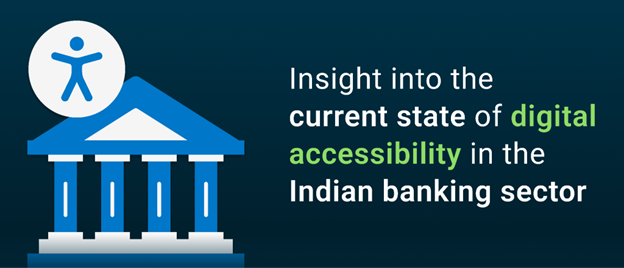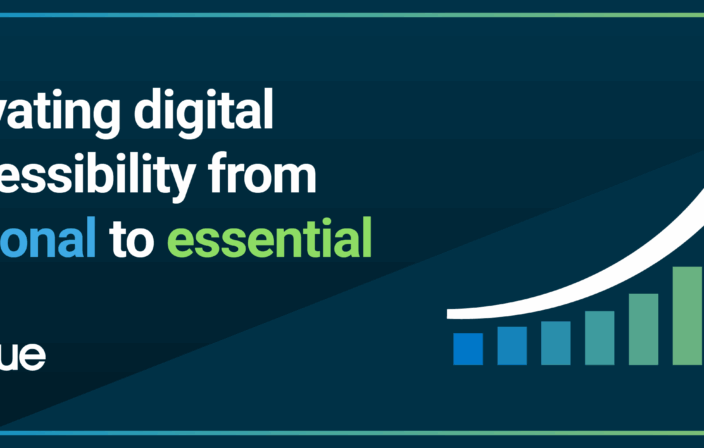Imagine that you have a visually impaired customer who wants to use your bank’s mobile app, but they can’t because the buttons aren’t labeled in a way they can understand. Or consider an elderly customer with shaky hands struggling to navigate your ATM touchscreen. These scenarios highlight the everyday challenges faced by millions of people in India when accessing digital banking services.
These are also the factors that influence which banking institutions people with disabilities choose to do business with. With over 2.7 crore people with disabilities in India, the need for digital accessibility in banking is both a legal requirement and a moral imperative. This article will provide you with a comprehensive understanding of why digital accessibility in the Indian banking sector is crucial and will include key statistics and an overview of current laws and regulations to help you recognize the significant benefits of implementing inclusive practices.
Why digital accessibility matters
Approximately 2.7 crore people living in India have a disability. This is a significant portion of the population that banks cannot afford to overlook. Making banking services accessible not only helps people with disabilities but also opens up a potential market worth $8 trillion globally, as highlighted by the Global Economics of Disability Report.
Key statistics


A survey by the Click-Away Pound Report found that 71% of customers with disabilities will leave a website that is not accessible. This means banks are potentially losing a substantial number of customers simply because their digital services are not user-friendly. These customers don’t stop banking; they go to another bank that is accessible.
These numbers underscore the everyday challenges millions of people in India face when accessing digital banking services. Barriers such as poor website navigation, non-compatible mobile apps, and inaccessible ATM interfaces create significant obstacles for those with disabilities. These issues need to be addressed urgently to foster a more inclusive society. By prioritizing digital accessibility, banks can ensure that all individuals can navigate their financial lives confidently and easily, regardless of their abilities. Additionally, improving accessibility opens up significant market opportunities by attracting a broader customer base—including people with disabilities—and helps banks avoid legal risks associated with non-compliance to accessibility regulations.
Regulatory framework and guidelines

India has laws and guidelines to promote digital accessibility in banking. To avoid legal issues, banks must understand and follow these regulations. Compliance with these laws ensures banks meet their obligations and build customer trust. Expert consulting can help banks navigate these regulations effectively, ensuring full compliance and improving their digital accessibility efforts.
- Rights of Persons with Disabilities Act, 2016 (RPwD Act): This law mandates accessibility standards across various sectors, including banking. The Ministry of Finance has issued “Accessibility Standards and Guidelines for the Banking Sector” to ensure inclusive services.
- RBI Guidelines: The Reserve Bank of India has issued guidelines to enhance banking accessibility, such as accessible ATMs, ramps for wheelchair users, and screen reader-compatible services.
- Bureau of Indian Standards (BIS) Guidelines: BIS has developed standards to ensure digital banking services are accessible, aligning with the RPwD Act.
- Accessible India Campaign: Launched by the government, this campaign aims to make all government websites and apps accessible to people with disabilities by 2025.
- Information Technology Act, 2000: This act includes provisions for making electronic and digital services accessible to all.
- GIGW Guidelines: The Guidelines for Indian Government Websites (GIGW) ensure that government websites, including those in the banking sector, follow international best practices in web accessibility, usability, and user-centric design, making them accessible to all users, including those with disabilities.
Benefits of digital accessibility
Investing in digital accessibility in banking offers numerous benefits:
- Increased market reach: Accessible digital platforms allow banks to attract a broader customer base, including people with disabilities. This expands the market and opens up new revenue streams, tapping into an underserved demographic with significant financial potential. Customers who encounter inaccessible sites and apps will not stop needing banking services; instead, they will take their business to banks that prioritize accessibility. By ensuring their services are accessible, banks can retain these customers and avoid losing them to more inclusive competitors.
- Compliance with regulations: Adhering to accessibility guidelines helps banks avoid legal issues and ensures compliance with national and international standards. This proactive approach mitigates the risk of litigation and aligns with evolving legal frameworks promoting inclusivity.
- Enhanced user experience: Accessible digital platforms are easier for everyone to use, leading to increased customer satisfaction. By removing barriers, banks can create seamless, intuitive experiences that benefit all users, regardless of their abilities. These positive experiences encourage repeat usage, leading to higher customer retention and loyalty over time. When customers find banking easy and enjoyable, they are more likely to use the services frequently and for longer periods, enhancing both customer acquisition and retention.
- Positive brand image: Demonstrating a commitment to inclusivity and accessibility enhances a bank’s reputation. Customers appreciate businesses prioritizing social responsibility, and an inclusive approach can foster loyalty and trust. Increasingly, consumers choose brands that align with their values. A strong commitment to accessibility signals that a bank values inclusivity and social responsibility, attracting and retaining customers who prioritize ethical business practices. This alignment with consumer values not only builds trust but also differentiates the bank in a competitive market.
- Technological advancements: When you bring in advanced digital accessibility tools, you’re leveraging the power of transformational technologies like AI and machine learning to accelerate innovation, drive positive change, and deliver business value. Technologies like AI and machine learning can enhance accessibility features, such as real-time text-to-speech conversion for visually impaired users.
Challenges and opportunities for achieving digital accessibility
Ensuring digital accessibility in the banking sector presents several challenges but also offers ample opportunities:
Lack of awareness and understanding
- Challenge: Many banks are unaware of the importance of digital accessibility and the needs of people with disabilities. This lack of awareness can lead to the exclusion of a significant portion of the potential customer base.
- Opportunity: Raising awareness can lead to the development of inclusive services, attracting and retaining more customers and enhancing market reach. Awareness campaigns and training can highlight the value of accessibility, promoting a culture of inclusion and improving customer satisfaction.
Technical challenges
- Challenge: Implementing digital accessibility requires significant technical adjustments, such as updating legacy systems and ensuring compatibility with assistive technologies.
- Opportunity: Overcoming these challenges can position a bank as a leader in innovation and accessibility, providing a competitive edge. Investing in modern, accessible technology can attract tech-savvy customers and those with disabilities, expanding the customer base.
Design and usability issues
- Challenge: Creating user-friendly and accessible designs involves careful consideration of various factors.
- Opportunity: Addressing these issues not only meets accessibility standards but also improves the overall user experience, benefiting all customers. Enhanced usability can lead to increased customer satisfaction, loyalty, and more frequent use of banking services.
Continuous improvement and testing
- Challenge: Digital accessibility is an ongoing process that requires regular testing and updates.
- Opportunity: Regularly testing platforms for accessibility issues and making continuous improvements based on user feedback and technological advancements keeps the bank responsive to customer needs, fostering customer trust and retention. This iterative process ensures that the bank stays ahead of regulatory requirements and industry standards.
Integration of assistive technologies
- Challenge: Integrating assistive technologies into digital platforms can be intensive.
- Opportunity: Successful integration leads to a more inclusive environment, broadening the bank’s customer base and opening new revenue streams. Embracing technologies like AI-driven accessibility tools can enhance the banking experience for all users, showcasing the bank’s commitment to innovation.
Training and development
- Challenge: Investing in staff training to understand and support accessibility requirements is crucial, but it requires executive buy-in and strategic planning.
- Opportunity: A well-trained team can effectively implement and maintain accessibility standards, enhancing the bank’s reputation for inclusivity. Continuous education programs can keep staff updated on best practices, ensuring consistent delivery of accessible services.
Feedback and iteration
- Challenge: Establishing channels for receiving feedback from users with disabilities and making iterative improvements are essential, but these channels need to be monitored and managed, and interactions need to be helpful and positive.
- Opportunity: Engaging with customers through feedback channels helps banks stay attuned to the needs of all customers, fostering loyalty and trust. This ongoing engagement can lead to better-designed products and services, improving the overall customer experience.
By addressing these challenges with a comprehensive approach that combines technical solutions, regulatory compliance, user-centered design, and a commitment to continuous improvement, banks can create inclusive digital experiences that benefit all customers. This balanced approach not only addresses immediate challenges but also leverages opportunities for growth, innovation, and enhanced customer loyalty.
Conclusion
Imagine a future where your bank not only meets regulatory requirements but also stands at the forefront of digital innovation and social responsibility. This isn’t just about compliance—it’s about capturing a market that is eager to engage, ensuring no customer is left behind, and setting a new standard in financial services. Leadership in accessibility translates to enhanced customer loyalty, a broader customer base, and a stronger market position. The numbers are clear: inclusivity is not just the right thing to do—it’s a smart business strategy.
Ready to make your banking services more accessible and inclusive? Contact Deque today for a comprehensive digital accessibility audit.


